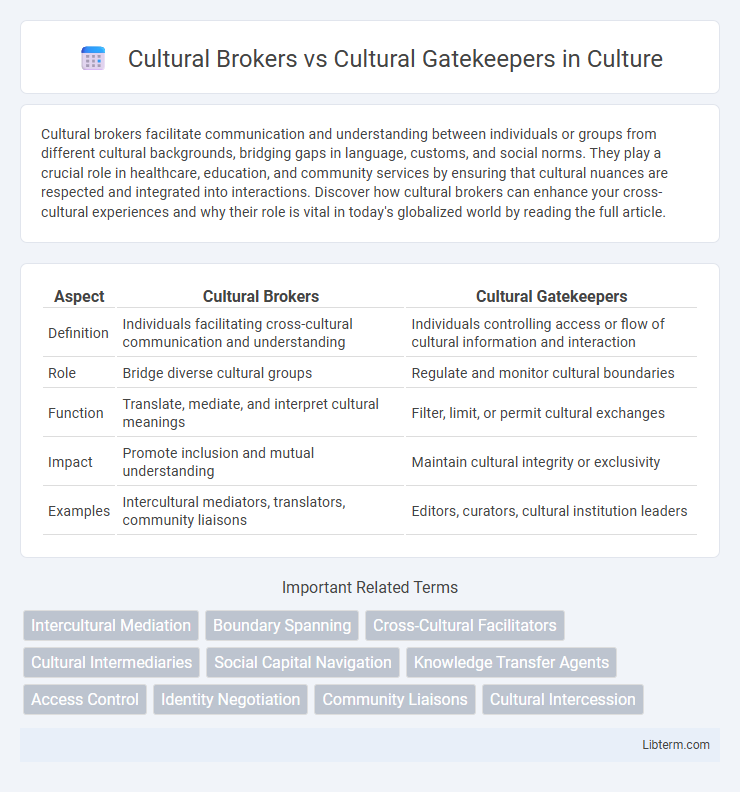Cultural brokers facilitate communication and understanding between individuals or groups from different cultural backgrounds, bridging gaps in language, customs, and social norms. They play a crucial role in healthcare, education, and community services by ensuring that cultural nuances are respected and integrated into interactions. Discover how cultural brokers can enhance your cross-cultural experiences and why their role is vital in today's globalized world by reading the full article.
Table of Comparison
| Aspect | Cultural Brokers | Cultural Gatekeepers |
|---|---|---|
| Definition | Individuals facilitating cross-cultural communication and understanding | Individuals controlling access or flow of cultural information and interaction |
| Role | Bridge diverse cultural groups | Regulate and monitor cultural boundaries |
| Function | Translate, mediate, and interpret cultural meanings | Filter, limit, or permit cultural exchanges |
| Impact | Promote inclusion and mutual understanding | Maintain cultural integrity or exclusivity |
| Examples | Intercultural mediators, translators, community liaisons | Editors, curators, cultural institution leaders |
Understanding Cultural Brokers and Cultural Gatekeepers
Cultural brokers facilitate communication and understanding between diverse cultural groups by interpreting customs, values, and language nuances, enabling smoother interactions and reducing misunderstandings. Cultural gatekeepers control access to cultural knowledge or social networks, influencing which cultural elements are shared or restricted within or between communities. Both roles are essential in multicultural settings, where brokers promote inclusion and gatekeepers maintain cultural boundaries.
Key Roles: Mediators vs. Barriers
Cultural brokers serve as vital mediators who facilitate understanding and communication between diverse cultural groups by bridging gaps in language, customs, and values. In contrast, cultural gatekeepers act as barriers by controlling access to cultural resources and information, often enforcing norms that limit cross-cultural exchange. The effectiveness of cultural brokers lies in their ability to promote inclusion and collaboration, whereas gatekeepers may inadvertently restrict intercultural dialogue and integration.
Historical Evolution of Cultural Intermediaries
Cultural brokers and cultural gatekeepers have evolved historically as key intermediaries navigating between diverse cultural groups and dominant societies. Cultural brokers facilitate cross-cultural understanding and exchange by translating and adapting cultural meanings, often emerging during periods of migration and colonization. Cultural gatekeepers control access to cultural production and dissemination, shaping public perceptions through selective endorsement and distribution since the rise of mass media and institutionalized culture.
Impact on Cross-Cultural Communication
Cultural brokers facilitate cross-cultural communication by bridging language barriers and cultural misunderstandings, enabling smoother interactions and mutual respect between diverse groups. Cultural gatekeepers control access to cultural knowledge and influence communication flow, which can either restrict or enable intercultural exchange depending on their openness. Both roles significantly affect the dynamics of cross-cultural communication, shaping outcomes in multicultural environments and global collaborations.
Power Dynamics and Influence
Cultural brokers act as intermediaries facilitating understanding and exchange between diverse cultural groups, often leveraging empathy and knowledge to bridge gaps without holding authoritative control. Cultural gatekeepers possess significant power to control access to cultural resources, narratives, or spaces, shaping which cultural expressions are validated or marginalized. The power dynamics highlight brokers' role in negotiation and translation, while gatekeepers hold dominant influence, determining cultural inclusion and exclusion within societal structures.
Navigating Identity and Representation
Cultural brokers facilitate understanding and connection between diverse cultural groups by translating values, customs, and beliefs, enabling authentic identity expression and representation. Cultural gatekeepers control access to cultural narratives and institutions, often influencing which identities are visible or marginalized within society. Navigating identity and representation involves balancing the broker's role in promoting inclusivity with the gatekeeper's power to shape cultural boundaries and definitions.
Challenges in Multicultural Environments
Cultural brokers navigate complex intercultural communication barriers, often facing challenges such as misinterpretation, identity negotiation, and maintaining neutrality while advocating for diverse groups. Cultural gatekeepers control access to cultural or institutional resources, encountering difficulties like resistance to change, enforcing dominant norms, and managing power imbalances in multicultural settings. Both roles require extensive cultural competence to mediate conflicts and facilitate inclusion within increasingly diverse workplaces and communities.
Case Studies: Notable Brokers and Gatekeepers
Case studies of cultural brokers like Malinowski reveal their role in facilitating communication and understanding between distinct cultural groups, promoting mutual respect and exchange. In contrast, cultural gatekeepers such as media regulators often control access to cultural content, influencing which narratives and traditions reach wider audiences and shaping cultural perception. Examining figures like Nelson Mandela as a broker and government censors as gatekeepers highlights the impact each has on cultural transmission and intercultural relations.
Strategies for Effective Cultural Mediation
Effective cultural mediation hinges on strategies employed by cultural brokers and gatekeepers, who facilitate cross-cultural understanding by translating norms, values, and communication styles between diverse groups. Cultural brokers emphasize empathetic engagement and active listening to bridge cultural gaps, while cultural gatekeepers control access to cultural knowledge and resources, requiring transparency and ethical negotiation to foster trust. Utilizing shared cultural references and promoting inclusive dialogue enhances mediation strategies, ensuring mutual respect and collaboration in multicultural environments.
Shaping the Future of Cultural Exchange
Cultural brokers facilitate cross-cultural understanding by bridging gaps between diverse communities, enhancing communication and collaboration across global societies. Cultural gatekeepers, on the other hand, control access to cultural knowledge and resources, influencing which cultural elements are preserved or transformed in the process of exchange. By balancing these roles, societies can shape the future of cultural exchange, promoting inclusivity and innovation in intercultural interactions.
Cultural Brokers Infographic

 libterm.com
libterm.com